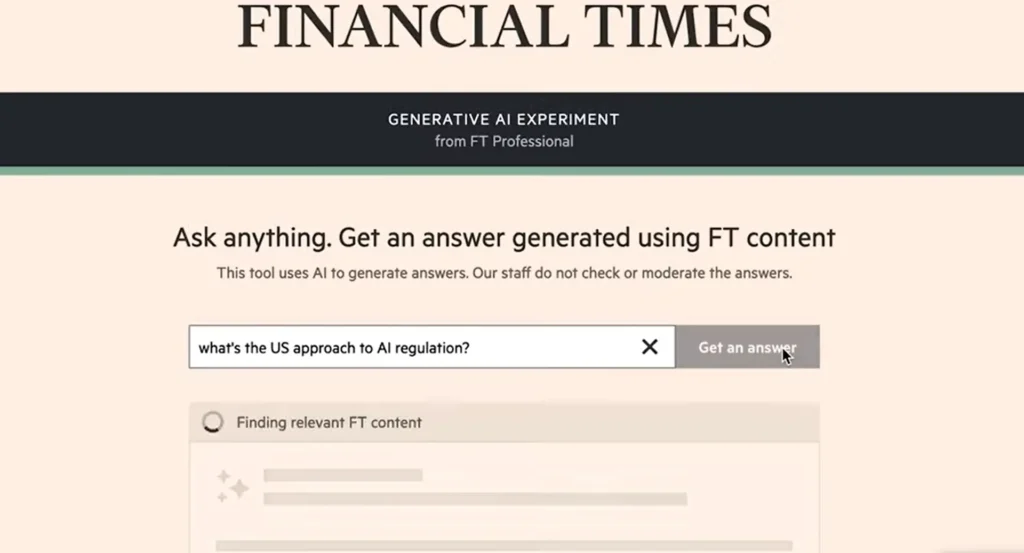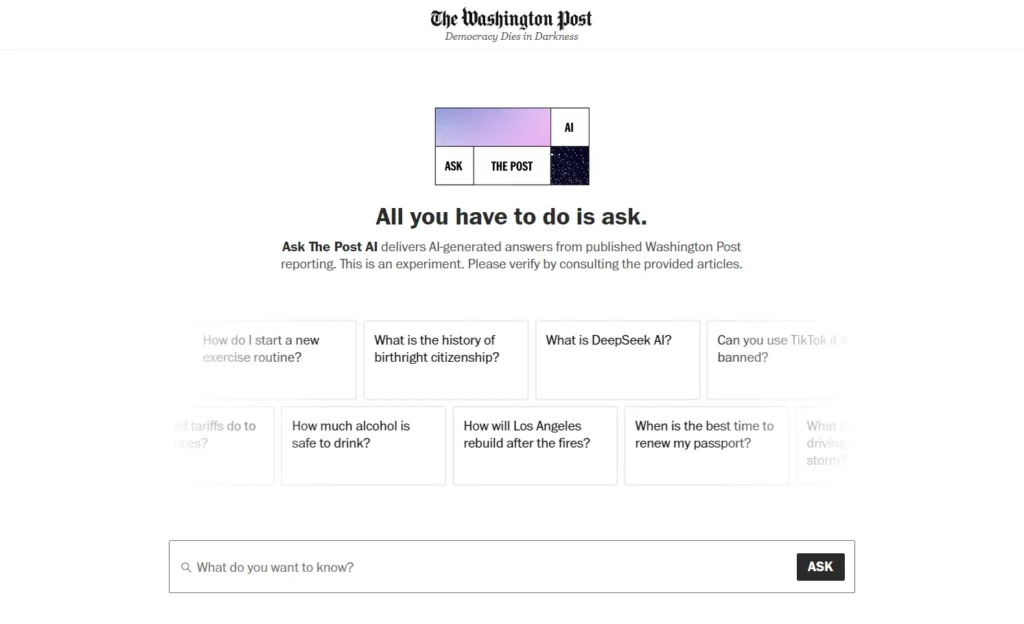AI in Newsrooms: Transformation, Integration, and Innovation

The integration of artificial intelligence (AI) into newsrooms has evolved from experimental curiosity to a cornerstone of modern journalism. Major media outlets are leveraging AI to enhance efficiency, engage audiences, and navigate an increasingly competitive digital landscape. While some fear AI’s disruptive potential, others see it as a tool to revitalize journalism. This article explores how leading organizations are adopting AI, with a focus on website integrations like the Financial Times’ ASK FT and The Washington Post’s groundbreaking “Ask The Post AI.“
Big Media Outlets Embrace AI for Efficiency and Innovation
Leading news organizations are deploying AI to streamline workflows and innovate content delivery. For instance, The New York Times invests in AI for dynamic paywalls, personalized recommendations, and in making it more accessible to more people: You can listen to most of the articles, through automated-voice technology, and read articles in Spanish created with the help of translation models. Inside the newsroom, editors may employ generative AI tools to create initial drafts of headlines, summaries of articles and other text that helps in producing and distributing the news.
Other outlets like Semafor and German tabloid Express.de use AI for headline optimization and automated curation, boosting click-through rates. Similarly, Reuters Institute reports that 56% of newsrooms prioritize AI for back-end tasks like transcription, tagging, and copy-editing, freeing journalists to focus on investigative work.
However, AI adoption is uneven. Well-resourced publishers develop in-house tools, while smaller outlets rely on third-party platforms like Google and Meta, risking “lock-in” effects that erode autonomy . Despite these challenges, AI’s role in automating repetitive tasks, such as generating summaries of financial reports or transcribing interviews, has become indispensable.
AI Integration on Media Websites: The ASK FT Example

In March 2024, the Financial Times introduced ASK FT, an AI-driven service allowing subscribers to query its archive for insights on business and economics. While details are limited in public records, such tools reflect a broader trend of using AI to enhance user interaction. By leveraging structured data and historical reporting, ASK FT exemplifies how media giants are transforming archives into interactive resources, though ethical concerns about sourcing and accuracy persist.
The Washington Post’s “Ask The Post AI”: A Case Study in Trustworthy AI
In November 2024, The Washington Post launched Ask The Post AI, a generative AI tool designed to answer reader questions using its articles published since 2016. This initiative stands out for its rigorous approach to accuracy and transparency:
- Exclusive Reliance on Verified Content: The AI draws answers solely from the Post’s reporting, avoiding “hallucinations” by refusing responses if insufficient sources exist .
- Enhanced User Experience: The tool provides concise, conversational answers linked to original articles, catering to mobile users and those seeking quick insights.
- Ethical Safeguards: Chief Technology Officer Vineet Khosla emphasized the tool’s alignment with the Post’s journalistic standards, ensuring AI complements, rather than replaces, human oversight.
This innovation builds on earlier AI projects like Climate Answers, a climate-focused chatbot, and audio article conversions, reflecting the Post’s strategy to blend technological innovation with editorial integrity.

Challenges and Ethical Considerations
Despite enthusiasm, AI adoption raises significant concerns:
- Trust Erosion: Over 70% of media executives worry AI could lower public trust in news, exacerbated by high-profile failures like CNET’s error-ridden AI articles.
- Job Displacement: Automating tasks like copy-editing threatens roles, though outlets like Le Monde use AI as an aid, retaining human checks for translations.
- Copyright Battles: Lawsuits, such as The New York Times’ case against OpenAI, highlight tensions over AI training on copyrighted content.
The Future of AI in Newsrooms
The trajectory of AI in journalism hinges on balancing innovation with accountability. Tools like Ask The Post AI demonstrate that AI can enhance accessibility without compromising accuracy. Meanwhile, collaborations between publishers and tech firms, such as Axel Springer’s deal with OpenAI, hint at potential revenue models, though smaller outlets risk exclusion.
As AI evolves, newsrooms must prioritize transparency, invest in ethical frameworks, and preserve human judgment. The goal is not to replace journalists but to empower them, a vision embodied by The Washington Post’s cautious yet forward-thinking approach.
In an era where speed often trumps depth, AI offers a paradox: the tools that threaten to dilute quality journalism could also be its greatest ally. The difference lies in how newsrooms wield them.